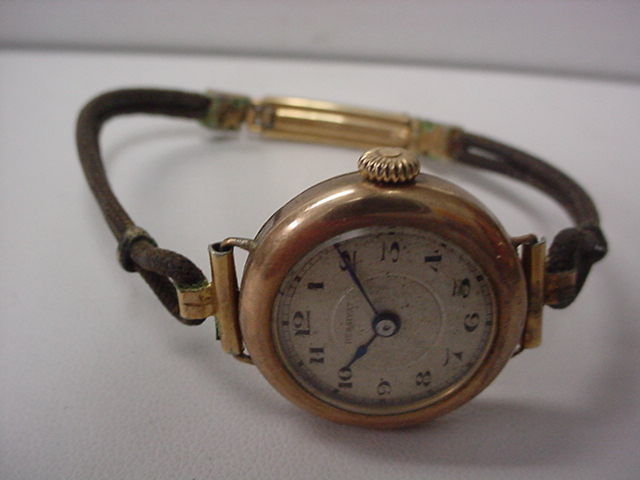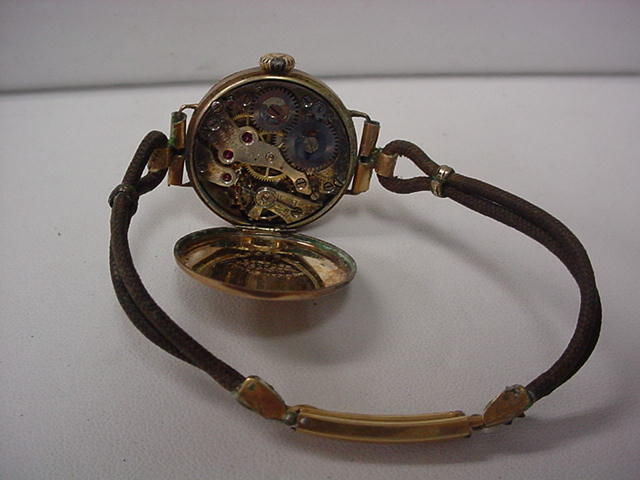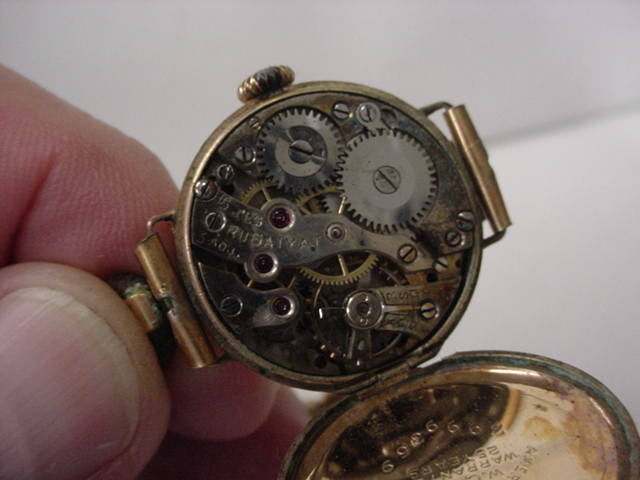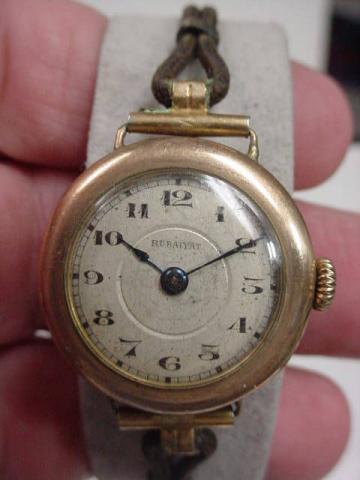Hi all,
Here's a fun one. I picked it up recently on eBay with a winning bid of only $20.50 and its keeping good time. I've gotten my money's worth just having fun researching and puzzling over it... I wanted to add it to the database for reference since I don't see much as far as old Rubaiyats and I also wanted to see what folks thought about it.
Its a very early Rubaiyat, possibly as early as 1917. I've read both Mark's fine article "Retracing Bulova History" and the information on LIsa's site about early Bulovas. This likely was made not too long after Bulova got the Rubaiyat trademark registered in May, 1917. It could even be earlier (Reverand Bob noted a listing for Rubaiyat dating to November, 1916 in Biel Switzerland by J. Bulova & Cie, Mark found a 1948 document that said the Rubaiyat trademark had been in use by Bulova since November 1916, and Will Smith posted about a 1917 Jewelers Circular Weekly that claimed use of Rubaiyat by Bulova dating back to November 1, 1916). BTW, great stuff in Mark's article and the accompanying comments and discussion...
Anyway, I found this watch interesting for several reasons. First, the case is marked "American Standard W.C. Co", so it presumably predates Bulova's acquisition of the American Standard company. It seems similar to the makings on the case of the Rubaiyat pocket watch posted by Mark in the discussion after his article. No globe or shield marking on the case, and the case number starts with "2", which would date it to 1917 under Lisa's list of characteristics for 1917 watches. I also noted that Will Smith's article "American Standard Cases Revisited C1919 through c1924 & later" included a Patent Office document that indicated that American Standard had been in use since August 1, 1918, but I assume that's when Bulova started to use it. Also, Lisa theorizes that the "American Standard W.C. Co" signiture pre-dates Bulvoa's ownership of American Standard, so perhaps this watch is either 1917, or early 1918 (before August 1, 1918)?
What is puzzling is that the watch has the crown at 3:00, not 12:00, so it doesn't square with LIsa's listing of characteristics that date a watch to 1917. Does that also point to early 1918?
As you can see in the photo, the movement is marked "Rubaiyat", not "Rubaiyat W. Co.". Also, there is no caliber or other markings on the movement other than "15 JLS" and "3ADJ". Rubaiyat is also on the dial. In any event, a very early Bulova...





Nice find!
I have trademarks for American Standard that date back to 1894, so they were in business long before old Joe started spending money buying companies...It is unusal that the stem is located at the 3:00 location when most pre 1920 ladies watches were converted pocket/pendant watches with lugs soldered on to accomadate a band.
The Rubaiyat on the dial is also a rare find, your money was well spent....

In reply to Doesn't it appear that the by Geoff Baker
Thanks Geoff. I don't see a lot of solder marks or anything like that where the lugs start on the case. Otherwise hard to tell since I really have not seem many early converted watches. I do have a 1918 ladies Elgin that is transitional, so I can dig that out and compare how the lugs look, but that watch is stored away right now...
Watches that were converted to trench wristlet watches were done by jewellers, and so would have been hard soldered. A competent goldsmith would have made the conversion almost invisible.
Pendant watches are almost always Lepine style, so unless the dial has been rotated and/or modified, a crown at 3 means the watch was intended to be a wrist style, or was a hunter pocket watch, albeit a small ladies one. I don't see a lot on the subject, but ladies' wristwatches would have been in common use before the soldiers started wearing them that way. Bulova's line for men was 1919?
Regardless, even a factory early wristwatch would have had soldered wire lugs.
In reply to Watches that were converted by Reverend Rob
Is it a fair assumption that because American Standard Watch Case Company wasn't founded until 1920 that any watch with this stamp cannot predate this year.
I totally agree that this is a very early bird, yet can't help but wonder about the following dates.
- A.W.C.Co (American Watch Case Company NYC: issued 8 August 1905
- Rubaiyat (straight): used since 1 November 1916
- Rubaiyat (wave): issued 15 May 1917
- American Standard: first used 1 August 1918
- Monogram (straight): used since 18 November 1919
- American Standard Watch Case Company: founded 1920
- Monogram (arched) issued: 12 April 1921 (used since 18 Nov 1919)
This shows that Rubaiyat was around prior (1917 onwards) but perhaps because it is cased in a ASWCCo case it actually dates 1920.
NOTE there is a difference between American Standard (1918), American Standard Watch Company (1886 and maybe earlier) and American Standard Watch Case Company (1920). The records show that the company was founded in 1920 not taken over by Bulova in 1920. Do we have any records to the contrary showing ASWCCo used at an early year?
Thoughts?
In reply to Is it a fair assumption that by mybulova_admin
In reply to noting the lack of a Globe or by FifthAvenueRes…

